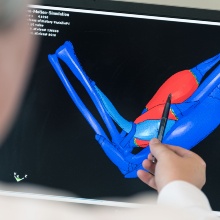In medicine, computer-aided (in silico) models can help to diagnose diseases more accurately and treat them more individually. However, this potential is still little used because cells and tissues such as muscles and organs have so far mainly been considered in isolation. A new DFG priority program, which was co-initiated by the University of Stuttgart, will now couple the models in order to better understand and predict the complex interactions between the structures and scales as well as their functions.
For example, continuum-mechanical models are required to understand how, in the interplay of the biceps and triceps muscles, a heterogeneous distribution of forces arises and acts. However, if the biophysical relationships are to be depicted realistically, they must be extended by chemo-electro-mechanical skeletal muscle models. This coupling leads to multi-scale neuromechanical functional models. So far, however, these have been greatly simplified and leave out, for example, the feedback mechanisms of the skeletal muscle system.
Similar problems arise in the modeling of metabolic processes in the liver, where models of chemical, biological, and fluid-dynamic effects need to be coupled on different time and size scales, or in models for understanding the complex processes in the brain. Understanding such relationships requires a systematic approach and innovative, coupled computer models that integrate all scales of biological systems, from molecules to complete organ systems or organisms. This requires skills from the fields of medicine, engineering, numerical mathematics, and computer science.
Interdisciplinary approach
Against this background, the DFG priority program (SPP) entitled “Robust Coupling of Continuum-Biomechanical in Silico Models of Active Biological Systems as a Preliminary Stage of Clinical Applications” is creating an interdisciplinary network that focuses on the research of new methodological approaches for coupling several computer-aided models and allows a three-dimensional view of their physiological functions. The SPP was initiated by professors Oliver Röhrle (Institute for Modeling and Simulation of Biomechanical Systems) and Tim Ricken (Institute of Statics and Dynamics of Aerospace Structures) from the University of Stuttgart, who are also the coordinators of the program. Scientists from the University Hospital of Rostock (Rainer Bader), the University of Erlangen-Nuremberg (Silvia Budday), and the University of Cologne (Axel Klawonn) are also involved.
Their goal is to further develop the existing methodological foundations as key competencies and thus enable the development of robust biomechanical models. Although the project does not reach the phase of clinical studies, it aims to create a platform for the qualification of biomechanical simulation models for later use in clinical practice.
Expert Contact:
Prof. Oliver Röhrle, University of Stuttgart, Institute for Modeling and Simulation of Biomechanical Systems, Department of Continuum Biomechanics and Mechanobiology, phone: +49 711 685-66284 email


